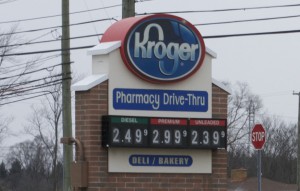
President Donald Trump is releasing some of the country's strategic petroleum reserves as gas prices soar.
U.S. gas prices are skyrocketing and, with as much as a quarter of the nation’s refinery capacity off-line in the wake of Hurricane Harvey, spot shortages are starting to develop in time for the Labor Day holiday.
That has prompted Pres. Donald Trump to release 1 million barrels of crude oil from the Strategic Petroleum Reserve. But that move is not expected to have any significant impact, especially not immediately, especially as refineries around the rest of the country are struggling to boost their output of gasoline and other distillates, rather than coping with shortages of crude.
The crisis touched off last weekend as Harvey made its first landfall was worsened as the storm went back out to sea, regained strength and then struck near the Louisiana-Texas border bringing more flooding and taking down the nation’s single largest refinery, in Port Arthur, Texas.
“The longer these refineries remain offline, the bigger the impact on gasoline prices,” Michael Tran, director of global energy strategy at RBC Capital said.
According to tracking service GasBuddy.com, spot shortages have begun popping up, especially in regions supplied by Gulf refineries. That includes places like the Texas capital of Austin, which took only a marginal hit from Hurricane Harvey. The website activated its Gas Availability Tracker, a crowdsourced feature designed to let motorists know what service stations have fuel and the electricity needed to operate their pumps.
(Hurricane Harvey could drench U.S. motorists with higher gas prices. For the story, Click Here.)
GasBuddy.com’s real-time tracker showed that, as of midday Friday the price of gasoline had jumped more than 17 cents since Harvey’s first landfall, at a nationwide average of $2.52 for a gallon of regular unleaded. Across Texas, the jump since last weekend was closer to 20 cents, though there have been reports of spot price gouging, one convenience store in Houston reportedly demanding $20 a gallon. How much higher things could go is far from certain.
The amount of rainfall and flooding that hit the Texas Coast is now being described as an all-time record for the U.S., though physical damage to the vast network of refineries along the Gulf of Mexico may be less than what was seen with other major hurricanes, such as Katrina, which devastated New Orleans a dozen years ago.
Even so, “The impact at the pump still is going to be noticeable, especially for millions of Americans ready to hit the roads for the holiday weekend,” Patrick Dehaan, an analyst with GasBuddy.com, told CNBC.
Dehaan said he expects the Gulf region could ultimately see prices surge as much as 35 cents a gallon, the rest of the country experiencing average increases of around 15 cents before things level off.
(Click Here for detail about how Hurricane Harvey is impacting the auto industry.)
One reason the situation won’t get even worse, according to various oil experts is that the nation’s reserves of both crude oil and refined products is relatively high right now. But the problem is that has meant refineries across the country were already operating at more than 90% of their capacity prior to the storm, offering little opportunity to pick up the slack – even if more crude is released from the Strategic Petroleum Reserve.
Some oil rigs in the Gulf have also shut down, however, and if that winds up leading to shortages in the weeks ahead, there are a few things experts say could be done to relieve pressure. That might include an Executive Order temporarily waiving the Jones Act. That measure normally requires that petroleum being moved between two U.S. ports be carried on American-made ships manned by U.S. crews.
Meanwhile, there are emergency supplies of gasoline located in three parts of the Northeast: New York, Boston and Maine. That reserve was created specifically to counter shortages created by natural disasters such as Superstorm Sandy.
How long the current price surge and spot shortages will last is far from certain. Holiday motorists will have to grin and bear it, but officials with the Motiva Refinery in Port Arthur, indicated they would try to restart the facility as soon as flood waters recede.
(To see how automakers are moving to help hard-hit Houston, Click Here.)
The biggest concern, for the moment, is what is happening far off in the Atlantic where another potentially massive storm, Hurricane Irma, continues to gain strength. It is so far too early to tell if it will take aim at the U.S. and, if so, where. But if it hit another major population center, especially in the South, the situation could grow far more dire.


Gas prices should be higher, the government should take this opportunity and hope to keep gas prices higher by raising the federal gas tax, which has not been done for decades. Additionally, the federal EV tax rebate should be raised from $7500, to $25,000, paid for by the raise in gas taxes. Gasoline-powered cars benefit from a tremendous subsidy in the form of unpriced externalities. An IMF report puts the worldwide total dirty energy subsidy (of which gasoline is a significant part) at $5.3 trillion per year. Another study suggests that the social costs (health, global warming, other destruction) of burning gasoline is $3.80 per gallon of gas, and $4.80 per gallon of diesel.
If we assume that the average car lasts 150,000 miles and compare that with the average efficiency of 25.5mpg then the average Car sold today will benefit from $22,353 in “incentives” by not having to pay the cost of the pollution they put out ($3.80 x (150k/25.5)). Hurricanes like Harvey are likely to become more common and devastating to the economy. We need to transition to clean energy and electric transportation.
Sorry CVVH have to disagree with you. Just where do you think much of the electric comes from? Coal. You think that is cleaner? Also Clean energy such as wind and solar have proven to be so expensive its not even feasible without gov. subsidies. Wind farms springing up everywhere and prices of electricity increasing. You worry about pollution and think the greed of the oil companys should be pandered to. Btw – The IMF is one of the most anti American run agencies in the world. Obviously you are arrogant enough to think that people are the “pollution”. So you obviously are for aborting a lot of the population as well as turning the U.S. into a 3rd world nation to protect the planet. This sort of thinking never fails to amaze me. If you follow the money you would find that the pollution and the problem are not the people so much as the big corp. giants who feed at the gov. trough.